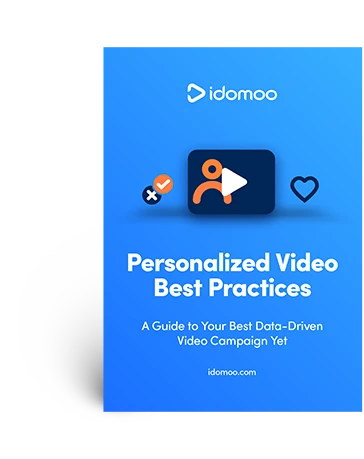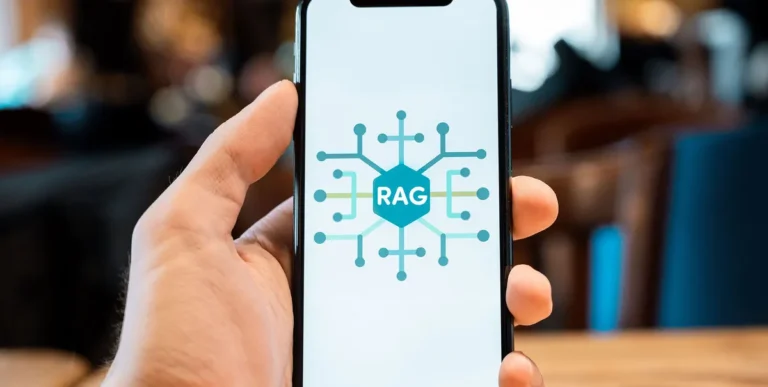As personalization becomes the new norm, it’s not surprising that Personalized Video is gaining traction. Most of us are no longer satisfied with generic content. We crave experiences that are relevant and tailored to us. In fact, 71% of consumers expect personalized interactions — with 76% getting frustrated when companies fail to deliver.
This shift in consumer expectations has made video personalization vital for brands. We’re talking about the art of tailoring video content to suit an individual viewer’s interests, needs and preferences. In other words, you’re going from a one-size-fits-all approach to video creation to one that’s personal and engaging.
Just think about the last time you received an email or watched a video that addressed you by name and provided recommendations based on your previous interactions — that’s personalized content in action.
So, if you’re ready to use Personalized Video to better connect with your audience and elevate your marketing strategy, keep on reading. First up? Understanding why personalization works.
The Psychology of Personalization
Why do we respond so positively to personalization in video content? The answer lies in the psychology of personalization, which taps into our fundamental human desire for control and our need to combat information overload, according to research from the University of Texas.
Personalized content is not just the same old stuff that everyone else is seeing. It’s made just for you, and that makes you feel like you’re in control. Even if it’s just a mental trick, knowing that what we’re watching is tailored to our preferences makes us feel more empowered and in charge of our choices. And that’s a powerful feeling!
But there’s more to it. The sheer volume of information available today can often lead to decision fatigue and information overload. We’ve all been there, scrolling through endless options, unsure of what to choose. Personalization cuts through that noise, offering precisely what you need and making the experience more manageable and enjoyable.
4 Ways To Add Personalization to Video
Now that we’ve delved into the science behind personalization, let’s shift gears and put it all into action. Here are some different options you have when it comes to personalizing video, along with video examples.
Personalizing Text
Text-based personalization is the most common form of personalization. It involves incorporating text elements that are tailored to each viewer. Some popular approaches are:
- Name personalization. Using the customer’s name within the video is a classic and effective method. Whether it’s a warm “Hello John,” or a congratulatory “Happy Birthday, Sarah!”, the call-out instantly grabs attention and makes the content feel more personal.
- Location personalization. You can also customize video content based on the viewer’s location. For example, a travel agency can show personalized flight deals from the viewer’s nearest airport.
- Purchase history. Mention a viewer’s past purchases or interactions with your brand to demonstrate that you know about their preferences and needs or to emphasize the value that you bring to the table.
Check out how SickKids Foundation shows their appreciation for monthly donors by addressing each one by name and showing heartwarming footage of the impact their donations have.
Personalizing Visuals
Visual personalization takes it to the next level by incorporating tailored visuals, images and graphics that’ll appeal to individual viewers.
One popular way to do this is by having the video dynamically adjust to show the most relevant product for each viewer. Let’s say an auto dealer wants to use video in an outreach campaign about maintenance services. The video’s visuals could be personalized so that the viewer sees the exact type of car they own, making the message relevant to their needs.
Another approach to visual personalization relates to representation. Characters or actors can be altered to align with the viewer’s gender, ethnicity or age. This prompts the viewer to relate to the content on a more personal level.
For example, BBVA encouraged retirement contributions with video messages from customers’ “future self,” with the actor reflecting the recipient’s gender. This made the message more relatable and emotionally impactful, effectively inspiring BBVA’s clients to contribute to their retirement savings.
When it comes to personalizing visuals in a video, the sky’s the limit. From using different images, graphics, scenes, and more, the possibilities are endless, so don’t be afraid to experiment and get creative with it.
Personalizing Audio
When we talk about personalization in video, it’s not just about what the audience sees; it’s also about what they hear. Think about videos where a voiceover greets the viewer by name or the language spoken is tailored to their demographic. This kind of personalization is a great way to engage your audience and add a human touch.
You can really get creative here. Draw inspiration from Orangetheory Fitness, which pushed the boundaries by getting a DJ to create personalized musical tracks that matched each member’s BPM. The tracks were then brought to life via Personalized Videos that celebrated their unique achievements.
The results? Orangetheory effectively got its members pumped for the new year, with over 45,000 additional classes booked and a record-high 97% attendance rate in the first week of the campaign launch. Plus, the brand scored its highest email open rate of any member communications sent out and 100% positive social mentions.
Interactivity
Finally, there’s interactivity, which involves adding elements that allow viewers to actively engage with the video. Here are some examples of what you can do with Interactive Video.
- Dynamic calls-to-action (CTAs): Interactivity lets you tailor your CTAs to each viewer’s individual behavior and preferences. For example, an e-commerce platform might show different CTAs, like “Shop Now” or “Learn More,” depending on how the viewer interacted with the video.
- Clickable hotspots: Clickable hotspots are like interactive links that let viewers explore more about specific topics in a video. For example, a fashion brand could create an Interactive Video where viewers can click on clothing items to learn more about them or buy them directly.
- Branching storylines. This feature is often seen in educational content or choose-your-own-adventure-style narratives. It allows users to choose their preferred option and shape the direction of the story based on their decisions.
- Quizzes and surveys. You can also collect valuable data by adding quizzes and surveys to your videos. Viewers can fill these out right in the video and you can use the data to recommend content they’re likely to enjoy or to just learn more about your viewers’ preferences and behaviors.
- Product customization. Customers can also customize and visualize products with Interactive Video features. Being able to select different colors, sizes or features often gives them a sense of ownership and a more personalized experience.
Interactivity turns passive watching into an active experience, making it a powerful tool for personalization. By letting viewers make choices, explore, and interact with the content, it creates a deeper connection and engagement, enhancing the overall impact of the video message.
Try it for yourself with the car payment calculator below and see how you can get different estimates based on how you customize the car to your liking.
A Step-By-Step to Video Personalization
As you can probably tell from the above examples, there are countless use cases for Personalized Video all throughout the customer journey. But regardless of whether you want to add it to the onboarding stage or as part of a year-in-review campaign, the process of adding personalization to videos follows a structured path. Let’s break it down into 5 basic steps.
1. Define Your Target Audience
It all starts with understanding your audience. To personalize your video content effectively, you need to know who your viewers are. Start by defining your target audience, taking into account their preferences, needs and behaviors. Create buyer personas to represent different segments of your audience. Consider factors like demographics, past interactions and interests.
From there, study the typical journeys your customers go through when interacting with your brand. Identify touchpoints where personalization can make the most significant impact. The more you know about your audience, the better you can tailor your video content to their liking.
2. Set Clear Goals and Objectives
Post on
Once you know who you’re trying to reach, it’s important to establish clear goals and objectives for your Personalized Video campaign. What do you want to achieve? Do you want to improve retention, boost conversion rate or something else?
By having a specific objective in mind, you can tailor your video content to serve that purpose effectively. For example, if you want to increase customer engagement, you could create an Interactive Video that asks viewers to take a specific action. Want to drive sales? Try crafting a personalized offer. And if you want to boost customer satisfaction, helpful explainer videos or tutorials that relay important information or address FAQs work wonders at cutting confusion.
3. Collect and Analyze User Data
Gathering viewer information is the next crucial step. You can collect data from various sources, including your website analytics, email marketing campaigns, CRM systems or social media interactions. Tools like Google Analytics, your CRM software and marketing automation platforms can also provide valuable insights into audience behavior.
Analyze this data to create a comprehensive picture of your audience and look for patterns and preferences that can guide your personalization efforts.
Critical Info: As much as consumers love personalization, they’re also wary of their personal information getting into the wrong hands. Be sure to get informed on the importance of data security for Personalized Video.
4. Create Dynamic Video Templates
Next, it’s time to get to creating. Rather than manually each video one by one, you’ll want to design dynamic video templates that will serve as the foundation of the campaign.
Put simply, the templates will be made up of interchangeable video pieces that can be mixed and matched to create unique videos for each customer. This approach streamlines the video production process while allowing for a high degree of personalization.
5. Test, Optimize and Repeat
Your final step is an ongoing one. Once your Personalized Videos are live, it’s essential to continually test their performance and gather feedback from your audience.
Conduct A/B tests to evaluate how well different personalized elements (images, CTAs, interactive features, etc.) are working. Collect user feedback and keep an eye on key performance indicators to make changes based on the data.
Remember, personalization is a continual process. As your audience changes, so should your personalization strategy. Regularly tweak your content and techniques to ensure your video content remains relevant and engaging.
Level Up With Personalized Video Marketing
Personalization is the name of the game when it comes to truly connecting with your audience. But to make video personalization a reality on a large scale, you’ve got to have the right tech on your side. That’s where platforms like ours step in.
Purpose-built for the creation and distribution of data-driven video, Idomoo’s Next Generation Video Platform makes launching Personalized Video campaigns a breeze with drag-and-drop simplicity, automation tools, omnichannel distribution and more. With us, you can scale your efforts effortlessly, reaching every member of your audience with tailored, impactful content.
So, ready to take your marketing game up a notch? Reach out to us at Idomoo. Your audience is eagerly anticipating one-of-a-kind experiences and it’s about time you delivered. Let’s make it happen.





